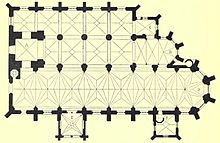St. Maria Magdalena (Goch)
The Catholic parish church of St. Maria Magdalena in Goch is a three-nave Gothic church building.
The Maria Magdalena Church became famous after the great tower collapsed on the night of May 24, 1993 at 2:27 a.m. The tower was built at the end of the 14th century.
history
The oldest parts are the central and north aisles. They were consecrated in the church in 1323, according to a record in the Goch church archive. It is assumed that a church had already stood in the same place, as Goch had already become an independent parish around 1200. The main nave of the church is the nave. Plans for this extension go back to the 15th century. The flourishing cloth weaving mill in Goch went hand in hand with the desire for a larger church. The south nave was demolished and the tall ship built as the main nave.
The situation for Catholics in Goch was dire at the beginning of the 17th century. Although 80% of the population were Catholic, the city's magistrate has consisted entirely of non-Catholics since 1617. From 1600 to 1621 the church was also used by the Reformed community. From 1621 the Catholics of Goch were allowed to use their church alone again, but the Reformed received the Beguine Monastery on Mühlenstrasse in return. As the town of Goch was quite rich from the cloth industry, there were up to 17 altars in this church, which were destroyed in the iconoclasm of Goch in 1625 by the soldiers of the governor of Nijmegen , Lambert Charles. The Dutch troops let out their anger because the church had been closed to their Reformed co-religionists since 1621. Within a few hours, almost all of the furnishings such as the pulpit, statues and stone monuments were destroyed, as well as the altars. Only the old tabernacle, the baptismal font from 1516 and the only picture “Madonna with the Child” from the 14th century and a statue of the holy knight George have survived .
The furnishings grew again in the 17th and 18th centuries. The baroque pulpit is worth mentioning . The nave suffered severe damage in 1945. The demolition of a pillar damaged 14 of 22 vault fields. The church was restored in its old form in 1959. For centuries, the churchyard served as a cemetery for the city's dead. At times Reformed and Lutherans were also buried here. The church tower was rebuilt in modern forms in 2003 - ten years after it collapsed.
Tower collapse in 1993
On May 24, 1993, at 2.27 a.m., the big church tower collapsed. A service was held in the church the evening before. Nobody was injured in the tower collapse.
Course of the accident
The pastor at the time, Johannes Baptist Ludes, saw the misfortune at first hand in the nearby rectory . His study had been badly damaged by a large boulder.
The church tower had collapsed, had destroyed the organ gallery and had tilted over the side nave to the neighboring rectory.
Cause of accident
A commission of experts from the diocese of Münster examined why the high tower collapsed. Finding the cause turned out to be difficult, and it turned out that a coincidence of unfortunate circumstances had led to a chain reaction at the end of which the church tower had collapsed. External influences had led to a negative change in the tower structure over time. The main reasons given were:
- Weathering and cracking in the masonry
- War aftermath of 1944
- Bell forces, released by an intense bell ringing 6 hours before the accident
- a local earthquake on April 13, 1992
- Substance changes in the masonry due to repairs.
The property damage was estimated at 20 million marks at the time.
organ
The organ building company Seifert (Kevelaer) built the new organ for St. Maria Magdalena in 2015 . The slider chests -instrument has 39 registers (2,433 pipes ) on three manuals and pedal . The Spieltrakturen are mechanically, the Registertrakturen electrically. The instrument was consecrated on the feast of Christ the King on November 22, 2015.
|
|
|
|
||||||||||||||||||||||||||||||||||||||||||||||||||||||||||||||||||||||||||||||||||||||||||||||||||||||||||||||||||||||||||||||||||||||||||
-
Pairing :
- Normal coupling: II / I, III / I, III / II, I / P, II / P, III / P
- Sub-coupling: II / I, III / I, II / II, III / III
- Super couple: II / I, II / II, III / III, II / P, III / P
Bells
Six bells with the chimes h 0 , d 1 , e 1 , f sharp 1 , a 1 , h 1 hang in the newly built tower . The bells were cast by the bell foundry Petit & Gebr. Edelbrock in Gescher - with the exception of the bells with the chimes f sharp 1 and a 1 , which survived the collapse of the tower.
Picture gallery
Bust of Arnold Janssen
Individual evidence
- ↑ RP ONLINE: May 24, 1993 in Goch: The day on which the church collapsed . In: RP ONLINE . ( rp-online.de [accessed on November 27, 2018]).
- ↑ Failure of structures. Volume 2: Buildings and special structures (J. Scheer) . In: Steel construction . tape 71 , no. 2 , February 2002, ISSN 0038-9145 , p. 161–161 , doi : 10.1002 / stab.200200440 .
- ↑ RP ONLINE: Goch: The misfortune of the century . In: RP ONLINE . ( rp-online.de [accessed on November 28, 2018]).
- ↑ Information on the new organ
Web links
Coordinates: 51 ° 40 ′ 37.6 ″ N , 6 ° 9 ′ 20 ″ E








